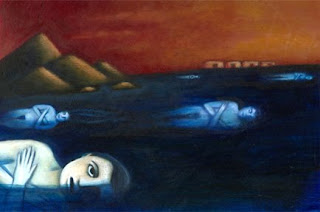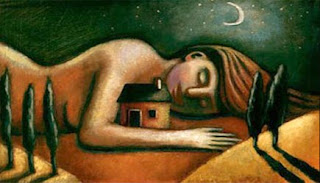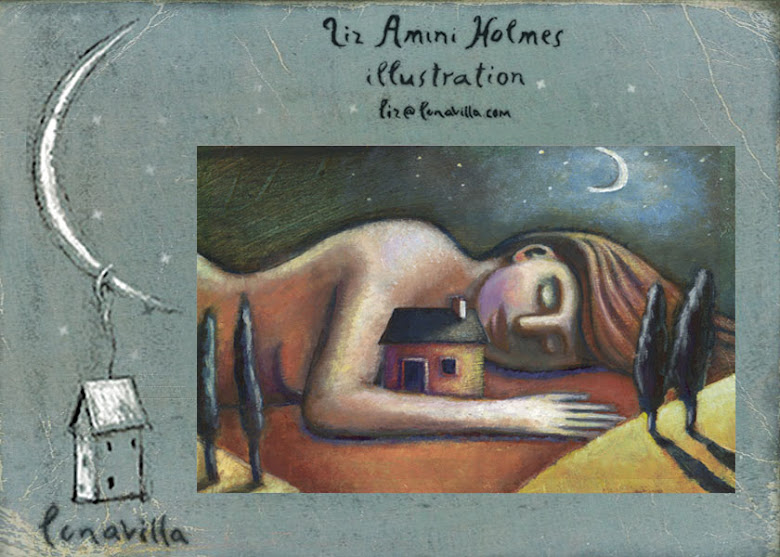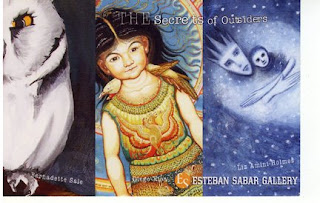WRIToracle
[Spring 2006]
Odd Little Journeys of an Artist's Mind
Liz Amini-Holmes
by Casie-Lee Miller
Artist Liz Amini-Holmes...makes you remember the places you have been, the places that may be so deeply submerged you didn’t even know they existed until a sound, a smell…an image triggers the remembrance.

What do you call that experience that leaves a feeling of remembrance in your stomach—that nervousness that comes when everything is just fine, when life is so calm you can actually feel the unknown drama marching toward you at the most somber of paces? Is it an irrational anxiety, one that is captured en masse in art and literature? Is it a feeling you’ve experienced before, perhaps in a dream - another world - when you know you’ve been in this same place before?
Artist Liz Amini-Holmes captures this sense - she makes you remember the places you have been, the places that may be so deeply submerged you didn’t even know they existed until a sound, a smell…an image triggers the remembrance.
It is Holmes’s ability to capture this sense of nostalgia that allows a viewer to relate to her pieces. More importantly, it is Liz’s ability to portray these human qualities and nostalgic senses so explicitly that allows the viewer to better understand themselves. “Some pieces are more about the tense moments that are just around the corner,” Holmes claims. Pursuit aptly captures those moments of tension. Holmes questions, “Why is the boy running? Is there a real threat or is it his imaginings?” In the painting there does appear to be definite danger: the boy is being chased by a white wolf. Yet, even Holmes doesn’t know if that wolf exists. What if the animal is imagined? While the boy is running from his projected fears, he is looking behind him and perhaps not noticing that he is heading into the thickest part of the forest. His very attempts to escape false threats have led him into real danger. Then what? Or perhaps even the forest is a figment. “I like the ambiguity about what will happen,” Holmes says. Then again, maybe he really is being pursued.
Perhaps it is Holmes’s ability to tap into her own consciousness which allows her to so effectively depict those universal doubts and emotional experiences. A recurring and less than pleasant dream Holmes has had since childhood places her in a caravan of cars driving along a road that slowly disappears into water. There is no land and nowhere to go but further into the aqueous depths. It is silent, lonely and forbidding, much like Awake.

A monochromatic blue river of bodies floats before the viewer in Awake. The surrounding land resembles “an almost primordial setting, as if the earth is still forming. The hills and low landline give you this undeveloped description of the world,” Holmes explains. In the foreground, a half submerged woman wakes. Her arms are folded across her chest as if she were in a casket. One eye stares out over the water. “It is about how we can pull ourselves to a sense of conciseness,” Holmes says, “with added macabre surprise that someone is alive in a sea of the dead.” Holmes later adds, “Perhaps that is how I see a lot of the world where so many are living, moving along, but asleep to what is around them except for the very few that are able to be awake.”
Usually Holmes chooses a rich color palette juxtaposing warm and cool tones to create conflict. For example, in Awake the land is composed of tans, reds and oranges, adding to the icy feel of the dead river. Each set of contrasting colors adds a deeper meaning to the conflict Holmes’s characters confront.

In Struggle there is another solitary eye staring out from what is this time a tumultuous sea. It is part of an unfinished tale Holmes developed, “about a wizard turned into a fish for his misdeeds.” The fish must face certain trials before he can become human again. Although the story was discarded, this scene was kept. “I liked the image of struggle the fish had in his eye, the determination to make it across the river but again adding the sense of fear that he knows he might not make it.”
Where Awake focuses on the simple reanimation—portraying humanity as having a zombie-like quality—Holmes’s Struggle portrays us, “as animals…thrash[ing] about trying to work our way through our lives.” However, in Waiting Holmes focuses her attention on imparting a sense of tranquility to her viewer; a tranquility made possible, in part, by Holmes’ predominately blue color palette. Even though Holmes feels that “color and mood really make [her] pieces,” she is now “experimenting with monochromatic color to test if it feels as satisfying.” The lack of color coupled with the simplicity of the subject matter in Waiting emphasizes the girl’s gaze, the moon over her shoulder, and the fact that she is almost completely submerged in water.
Waiting is a piece “about being calm and letting yourself sit and wait for things to come to you and not try to push so hard as we, particularly Americans, tend to do. The calm effect of just being. Maybe she is asking, ‘What are you waiting for?’ Or she will wait for you while you pull yourself together. It is the converse of Struggle. I think both can be relevant ways to be, but perhaps a balance of both is in order to be satisfied.”
Holmes’ work is a long series of self-discovery, a journey that seeks the very balance Holmes depicts through contrasting paintings. And, even though Holmes’s professes there is currently no statement to her work, her favorite pieces tend to be those centered on the hearth and home theme. While these particular paintings are upbeat and offer the viewer a sense of warmth and security, they also provide a visceral connection to the adult of the child within. It’s almost as if these paintings serve as reminders to not forget the significance of those sometimes long forgotten childhood wants and yearnings. There is “a bittersweet quality that emanates” from some of these pieces; a “sweet, sad aspect of life” that Holmes “let…leak into [her] work.” Perhaps it is this bittersweet quality that triggers those memories, sometimes generating warmth, at others an ache. These are the same bittersweet memories Holmes experienced as a child. “I had a pretty up heaved life when I was young. My family had a lot of financial and personal problems. We would settle into nice homes then have to move again and again due to family issues. But because we are so close…particularly because of my grandmother [who] was the foundation of our family, we felt security.”

The security imparted by Holmes’s grandmother can be found in Dreaming, a favorite of the artist’s. Dreaming depicts a woman asleep while cuddling a house like a teddy bear. This is the dream and security blanket of an adult, the dream of finally finding your niche. “I have a very wonderful home with my husband who is also an artist and my two five-year-old awesome boys. We live on property my grandmother gave me when she died that had been in our family for almost 70 years. I feel her presence in this place and that make me feel secure.”
The reflection of the green trees in the night sky gives Dreaming a supernatural glow. The giant woman could be seen as representing the artist, all grown up yet still possessing the child-like qualities and desires from her past. Or, perhaps she is the grandmother, revisiting her home and her family, protecting them while they live and sleep. “Her wily spirit lives here and somehow watches over us all,” Holmes says of the matriarch. “I always liked the idea of generational home and not for the elitist factor associated with them but how children can see how families evolve and a house has a life and story to it and that they can pass along those stories down to their children. We don’t have many of those places anymore. Homes are torn down often or people move so much that any sense of history is gone and I think it makes us a bit lonely and disconnected.” And yet, Liz Amini-Holmes struggles with the notion of what makes a house a home. Is “a structure really important or is [it] the family itself…?”
As Liz Amini-Holmes continues her exploration into both the field of fine art and self-discovery, she will most likely achieve her goal of amassing “a bigger body of work that has consistent themes.” The journey will prove interesting for the viewer, especially if Liz Amini-Holmes continues “to share with others the odd little journeys of [her] mind.”
Visit Liz Amini-Holmes at www.lunavilla.com
*Edited by Wendy Harrison*








